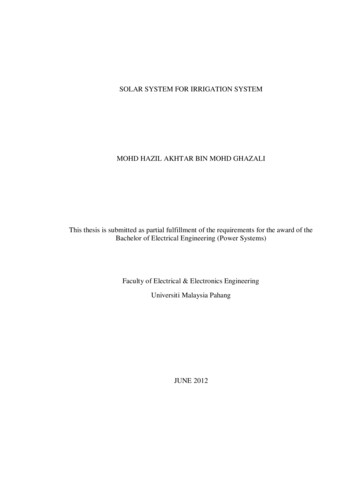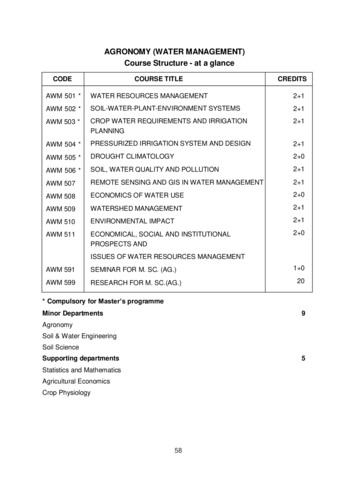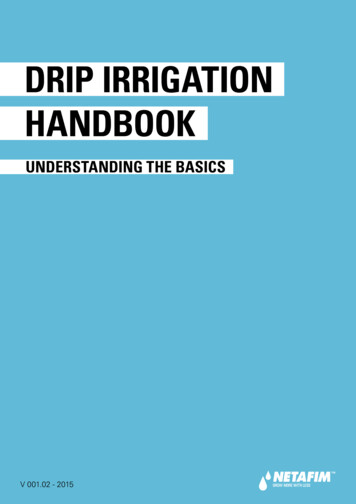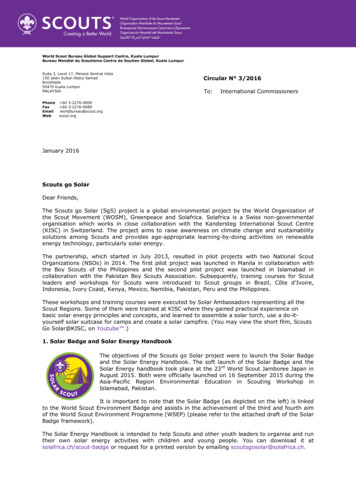
Transcription
SOLAR SYSTEM FOR IRRIGATION SYSTEMMOHD HAZIL AKHTAR BIN MOHD GHAZALIThis thesis is submitted as partial fulfillment of the requirements for the award of theBachelor of Electrical Engineering (Power Systems)Faculty of Electrical & Electronics EngineeringUniversiti Malaysia PahangJUNE 2012
vABSTRACTSolar power is absolutely perfect for use with irrigation systems for gardens,grass such as golf course, field and especially for planting. Using 12 V Solar Panel,the sun energy will converted to electrical power and saves to 12 V batteries. Whenthe sun is rising and shining, the solar panel will absorb the energy of the sun and theenergy will keep in the battery. The battery will supply the power to the water pump.By using the timer, the irrigation system will turn on the pump at the same timeevery day. We also can use relay to supply the power of the pump or many otherpump with our choice to ON/OFF the pump every day. The system will turn OFFwhen the electrical conductivity probes detect the suitable value of soil moisture.
viABSTRAKTenaga solar adalah benar-benar sempurna untuk digunakan dengan sistempengairan untuk taman-taman rumput, seperti padang golf, padang dan terutamanyauntuk penanaman. Menggunakan 12 V Panel Suria, tenaga matahari akan ditukarkepada kuasa elektrik dan menjimatkan hingga 12 V bateri. Apabila matahari naikdan bersinar, panel solar akan menyerap tenaga matahari dan tenaga akanmenyimpan dalam bateri. Bateri akan membekalkan kuasa kepada pam air. Denganmenggunakan pemasa, sistem pengairan akan menghidupkan pam pada masa yangsama setiap hari. Kita juga boleh menggunakan geganti untuk membekalkan kuasapam atau pam lain dengan pilihan kami untuk ON / OFF pam setiap hari. Sistemakan OFF apabila probe kekonduksian elektrik mengesan nilai yang sesuaikelembapan tanah.
viiTABLES OF CATIONiiiACKNOWLEDGEMENTivABSTRACTvABSTRAKviTABLE OF CONTENTSvii - ixLIST OF TABLESxLIST OF ABBREVIATIONSxi1LIST OF FIGURESxiiLIST OF m Statement2-31.3Project Objectives1.4Project Scope33
viii2LITERATURE REVIEW AND THEORY2.1Introduction2.2Solar energy2.3Solar Panel4452.3.1 Monocrytalline Solar Panel62.3.2 Polycrytalline Solar Panel62.3.3 Thin-film Solar Panel2.42.52.62.76-7Battery72.4.1 Nickel Cadmium (Ni-Cd)82.4.2 Lithium Ion (Li-ion)92.4.3 Lead Acid9-10Timer112.5.1 Mechanical Timer112.5.2 Electromechanical Timer12-132.5.3 Elcetronic Timer132.5.4 Computer Timer14Soil Moisture Sensor152.6.1 Tensiometer162.6.2 Electrical Conductivity Probe16-172.6.3 Electrical Resistance Blocks172.6.4 Heat Dissipation Sensors17-18Relay182.7.1Latching Relay192.7.2Reed Relay19-202.7.3Mercury-Wetted Relay202.7.4Contactor Relay212.7.5Overload Protection Relay22
ix3METHODOLOGY3.1Introduction3.2Flowchart of the Project3.3Solar Charge Controller Circuit3.42324-25253.3.1 Circuit Introduction253.3.2 The Circuit Operation26Soil Sensor Meter27-283.4.1 Sensor Specification4RESULT AND ANALYSIS4.1Introduction4.2Solar System for Irrigation System Prototype4.3Solar Panel Maximum Power30-314.4Controller Circuit324.5Power Supply Circuit4.6PIC 16F877A (Microcontroller)334.7Simulation by using Proteus334.7.1 Simulation Result34-35The Charge Controller Circuit35-404.84.928Soil Moisture Sensor Meter52929-303241-43CONCLUSION AND RECOMMENDATION5.1Conclusion445.2Problem PENDICES48-55
xLIST OF TABLESTABLE NO.TITLEPAGE3.1Sensor Specification284.1Voltage Reading at Solar Panel30-314.2Data during the battery charging374.3Discharging Process Using DC Motor40
xiLIST OF ABBREVIATIONSDC-Direct currentVdc -Voltage direct currentVin-Input voltageVo-Output voltage
xiiLIST OF FIGURESFIGURE NO.TITLEPAGE2.1Solar Panel52.2Battery82.3Lithium Ion Battery92.4Lead Acid Battery102.5Timer112.6Mechanical Timer122.7Electronic Timer132.8Soil Moisture Sensor152.9Tensiometer162.10Electrical Conductivity Probes172.11Relay192.12Reed Relay2.13Mercury-wetted Relay2.14Contactor Relay223.1Flowchart Diagram243.2Charge Controller Circuit253.3Soil Sensor Meter274.1Complete Design Project (Top View)294.2Complete Design Project (Side View)304.3Voltage on Solar Panel314.4PIC Circuit324.5Power Supply Circuit324.6Microcontroller (PIC 16F877A)334.7Circuit Drawing in Proteus Software334.8Result in Proteus Software344.9Result in Proteus Software352021
xiii4.10Drawing of Charge Controller Circuit354.11DC Power Supply Connected to the Circuit364.12Battery in Low Conditions384.13The Circuit (ON Conditions)394.14Battery in Full Conditions394.15Graph for discharging process404.16Soil Moisture and PIC Controller Circuit4.17Voltage Controller Circuit424.18Reading for Solar Panel and Soil Sensor424.19The Pump is Turn OFF4341
xivLIST OF APPENDICESAPPENDIXATITLEPAGEProgramming Coding48-55
CHAPTER 1INTRODUCTION1.1BackgroundElectricity is a general term encompassing a variety of phenomena resulting fromthe presence and flow of electric charge. Nowadays, electricity is very important to us.Without electricity, our daily life is not complete. However, electricity tariff is increasedue to the gas price [1]. So, alternative energy or renewable energy is suitable for us togain energy and save our money.There are many types of alternative energy such as wind, solar energy, nucleargeneration, hydroelectric, thermal and many more. The alternative energy thatcommonly use nowadays is Solar system or Photovoltaic (PV). Photovoltaic (PV) is amethodof generatingelectricalpower bycurrent electricity using semiconductorsthatconverting solarexhibitradiationinto directthe photovoltaiceffect[2].Photovoltaic power generation employs solar panels composed of a number of solarcells containing a photovoltaic material.1
Thus, in this project, the implementation of solar energy is use for irrigationsystem. Irrigation system nowadays is not very practical which is time wasting andinvolving of human power.There are many type of irrigation system such as surface, drip irrigation, watersprinkler, sub-irrigation and many more. Many of this irrigation system used manual andautomatic control. This automatic control use electricity to operate the irrigation system.By using the solar system or photovoltaic system (PV), electricity and money can besave. Besides that, by using automatic irrigation that powered by solar, more time can besaved.Many benefits that we can get by using this alternative energy.One majoradvantage with the use of renewable energy is the source is sustainable and it will neverrun out. Renewable energy facilities generally require less maintenance than traditionalgenerators. Their fuel being derived from natural and available resources reduces thecosts of operation.Even more importantly, renewable energy produces little or no waste productssuch as carbon dioxide or other chemical pollutants, so it has minimal impact on theenvironment. Renewable energy projects can also bring economic benefits to manyregional areas, as most projects are located away from large urban centers and suburbsof the capital cities. These economic benefits may be from the increased use of localservices as well as tourism.1.2Problem StatementsNowadays, raw materials such as natural gas are decreasing and price of thisnatural gas are increase due to the market price. This natural gas is very important toproduce electricity. For example, many Power Generation or Power Plant uses naturalgas to produce electricity. So, to minimize the usage of this natural gas, we can use the2
alternative ways such as solar energy. Besides that, this alternative energy also dot notharm to the environment.Water is very important to us. There are many usage of water such as for drinks,bath, and to wash clothes. Besides that, water also important to water plant becausewater can give nutrition to the plant. But, irrigation system that many people use is notvery practical. This is because the irrigation nowadays uses the human power.Furthermore, a lot of water has been wasted because of careless management of manualirrigation system. So, by this solar system for irrigation system, many time and watercan be saved.1.3Project ObjectiveThe objectives of doing this project arei.To design the simple and practical irrigation system that using SolarPanel.ii.Develop a smart charger controller to collect and store solar energy inbattery.1.4Project Scopea)Build a circuit for irrigation system that using Solar system.i. water pump (dc)ii. timeriii. sensoriv. relay switchb)Build a solar charger controller.c)Build a controller circuit using Microcontroller3
CHAPTER 2LITERATURE REVIEW2.1IntroductionThis chapter presents an overview of solar system. Solar photovoltaic (PV)system has been recognized as suitable for power generation in countries where there arehigh levels of solar radiation.2.2Solar EnergySun provided the earth with various energies such as in the form of solar energy,radiant light and heat[5]. These energies have been utilized and develop in humancivilization since ancient times. Across the centuries, there are many other alternativeenergies have been discovered and hence competitions between the sources of energystart from solar radiation to the other resources such as hydroelectricity, wind energy,wave power and also thermal.4
2.3Solar PanelA solar panel is a collection of solar cells. Although each solar cell provides arelatively small amount of power, many solar cells spread over a large area can provideenough power to be useful. To get the most power, solar panels have to be pointeddirectly at the Sun. Solar panels need surface area, more exposure means moreelectricity can be converted from light energy [2].Solar energy absorbed by solar panel or in other word Photovoltaic Cell (PV).‗Photo‘, meaning light, and ‗voltaic‘, meaning electricity. Photovoltaic systems usesilicon cells to convert solar radiation into electricity [2].The PV system captures thesun‘s energy using solar photovoltaic cells. The cells convert the sunlight intoelectricity, which can be used to run household appliances and lighting.Each cell is madefrom one or two layers of semi-conducting material, usually silicon.Photovoltaic(PV) cells are the special made semiconductor such as silicon,widely use.Basically when the light strikes the cell,a certain portion of it absorbed bysemiconductor – energy transferred to semiconductor.Energy knocks the electron,allowing them to move freely. PV also has electric field that only allow electron move incertain direction.This flow of electron we called current[2].Figure 2.1: Solar Panel5
2.3.1Monocrystalline Solar PanelMonocrystalline silicon often made using the Czochralski process. Single-crystalwafer cells tend to be expensive, and because they are cut from cylindrical ingots, do notcompletely cover a square solar cell module without a substantial waste of refinedsilicon[5]. Hence most monocrystalline solar panelhave uncovered gaps at the fourcorners of the cells.2.3.2Polycrystalline Solar PanelPolycrystalline silicon, ormulticrystalline silicon, (poly-Si or mc-Si): made fromcast square ingots — large blocks of molten silicon carefully cooled and solidified.Polycrystalline cells are less expensive to produce than single crystal silicon cells, butare less efficient. However, there were a higher number of multicrystalline sales thanmonocrystalline silicon sales due to the economical cost[2].2.3.3Thin-Film Solar PanelThin-film technologies reduce the amount of material required in creating theactive material of solar cell. Though this reduces material cost, it may also reduceenergy conversion efficiency. Thin-film silicon cells have become popular due to cost,flexibility, lighter weight, and ease of integration, compared to wafer silicon cells.Diodes are often included to avoid overheating of cell in case of partial shading.Since cell heating reduces the operating efficiency it is desirable to minimize theheating. Very few modules incorporate any design features to decrease temperature,however installer try to provide good ventilation behind the module.6
The power produced by the solar array depends on the weather conditions, theposition of the sun and the capacity of the array. At noon on a bright day, a good arraycan produce over 2 kilowatt (2.6 hp). A 6 m² array of 20 % cell will produce roughly 6kW-h (22 kJ) of energy during typical day on the Malaysia weather at daily insulation of4 hours[6].In brief, thin-film solar panel are the suitable commercially viable photovoltaicsolar collectors among three type solar panel. PV panel made from thin-film is suitablefor Malaysia weather [2].2.4BatteryA battery, which is actually an electric cell, is a device that produces electricityfrom a chemical reaction. Strictly speaking, a battery consists of two or more cellsconnected in series or parallel, but the term is generally used for a single cell. A cellconsists of a negative electrode; an electrolyte, which conducts ions; a separator, also anion conductor; and a positive electrode.The electrolyte may be aqueous (composed of water) or non-aqueous (notcomposed of water), in liquid, paste, or solid form. When the cell is connected to anexternal load, or device to be powered, the negative electrode supplies a current ofelectrons that flow through the load and are accepted by the positive electrode. When theexternal load is removed the reaction ceases.A primary battery is one that can convert its chemicals into electricity only onceand then must be discarded. A secondary battery has electrodes that can be reconstitutedby passing electricity back through it; also called a storage or rechargeable battery, it canbe reused many times.7
Figure 2.2: Battery2.4.1Nickel Cadmium (Ni-Cd)Nickel Cadmium (Ni-Cd) batteries were the standard technology for years, buttoday they are out of date and new laptops don't use them anymore. They are heavy andvery prone to the "memory effect". When recharging a NiCd battery that has not beenfully discharged, it "remembers" the old charge and continues there the next time youuse it[17]. The memory effect is caused by crystallization of the battery's substances andcan permanently reduce your battery's lifetime, even make it useless. To avoid it, youshould completely discharge the battery and then fully recharge it again at least onceevery few weeks. As this battery contains cadmium, a toxic material, it should always berecycled or disposed of properly.NiCad batteries, and to a some degree NiMH batteries, suffer from what's calledthe memory effect [17]. Memory Effect means that if a battery is repeatedly onlypartially discharged before recharging, the battery will forget that it can furtherdischarge. The best way to prevent this situation is to fully charge and discharge yourbattery on a regular basis.8
2.4.2Lithium Ion (Li-ion)Lithium Ion (Li-ion) are the new standard for portable power. Li-ion batteriesproduce the same energy as NiMH but weighs approximately 20%-35% less[18]. Theydo not suffer significantly from the memory effect unlike their NiMH and Ni-Cdcounterparts. Their substances are non-hazardous to the 0.Because lithium ignites very easily, they require special handling. Unfortunately,few consumer recycling programs have been established for Li-ion batteries at this pointin time.Figure 2.3: Lithium Ion battery2.4.3Lead AcidA lead-acid battery is a electrical storage device that uses a reversible chemicalreaction to store energy. It uses a combination of lead plates or grids and an electrolyteconsisting of a diluted sulphuric acid to convert electrical energy into potential chemicalenergy and back again [19]. The electrolyte of lead-acid batteries is hazardous to yourhealth and may produce burns and other permanent damage if you come into contactwith it. Thus, when dealing with electrolyte protect yourself appropriately.9
Figure 2.4: Lead Acid batteryAfter all, a few properties have been determined where a battery should:a. Provide enough voltage at full charge roughly around 12 V to 12.8 Vb. High discharge down rate as much as least 60% and above at time after time.c. Not easily damaged by excessive rate of overcharge, discharge or evennegative charge within to tolerable range.d. Safe in operation when exposed to harsh ambient environmente. Low in cost since more than one cell is requiredThus, on the whole that deep cycle lead acid batteries perform the overallcharacteristic to be used in the project. A deep cycle lead acid battery is designed to beregularly discharged to most of its capacity.Besides that, it is sufficient to powered output to load more than 12 V[19].Certainly, the low cost of deep cycle lead acid battery is an attractive point beside lessdangerous compare to volatile lithium-ion cell. Therefore, deep-cycle lead acid batteriesare more suitable to be installed in stand-alone solar system in rural area in this project.10
2.5TimerA timer is a specialized type of clock. A timer can be used to control thesequence of an event or process[4]. Whereas a stopwatch counts upwards from zero formeasuring elapsed time, a timer counts down from a specified time interval, likean hourglass. Timers can bemechanical, electromechanical, electronic (quartz), oreven software as all modern computers include digital timers of one kind or another.When the set period expires some timers simply indicate so (e.g., by an audible signal),while others operate electrical switches, such as atime switch, which cuts electricalpower.Figure 2.5: Programmable Timer2.5.1Mechanical TimerMechanical timers regulate their speed. Inaccurate, cheap mechanisms use a flatbeater that spins against air resistance. Mechanical egg-timersare sometimes of thistype.More accurate mechanisms have mechanisms similar to mechanical alarm clocks;they require no power, and can be stored for long periods of time. The most widelyknown application is to control explosives.11
Figure 2.6: Mechanical Timer2.5.2Electromechanical TimerShort-period bimetallic electromechanical timers use a thermal mechanism, witha metal finger made of strips of two metals with different rates of thermalexpansion sandwichedtogether; steel and bronze arecommon.An electriccurrentflowing through this finger causes heating of the metals, one side expands lessthan the other, and an electrical contact on the end of the finger moves away from ortowards an electrical switch contact[7]. The most common use of this type is in the"flasher" units that flash turn signals in automobiles, and sometimes in Christmas lights.This is a non-electronic type of multivibrator.An electromechanical cam timer uses a small synchronous AC motor turninga cam against a comb of switchcontacts. The AC motor is turned at an accurate rate bythe alternating current, which power companies carefully regulate. Gears drive a shaft atthe desired rate, and turn the cam. The most common application of this timer now isin washers, driers and dishwashers. This type of timer often has a friction clutch betweenthe gear train and the cam, so that the cam can be turned to reset the time [9].Electromechanical timers survive in these applications because mechanicalswitch contacts may still be less expensive than the semiconductor devices needed tocontrol powerful lights, motors and heaters.In the past these electromechanical timerswere often combined with electrical relays to create electro-mechanical controllers.Electromechanical timers reached a high state of development in the 1950s and 60s12
because of their extensive use in aerospace and weapons systems. Programmableelectromechanical timers controlled launch sequence events in early rockets andballistic missiles[8]. As digital electronics has progressed and dropped in price,electronic timers have become more advantageous.2.5.3Electronic TimerElectronic timers are essentially quartz clocks with special electronics, and canachieve higher precision than mechanical timers. Electronic timers have digitalelectronics, but may have an analog or digital display. Integrated circuits havemade digital logic so inexpensive that an electronic timer is now less expensive thanmany mechanical and electromechanical timers[10]. Individual timers are implementedas a simple single-chip computer system, similar to a watch and usually using thesame, mass-produced, technology.Many timers are now implemented in software. Modern controllers usea programmable logic controller rather than a box full of electromechanical parts. Thelogic is usually designed as if it were relays, using a special computer languagecalled ladder logic. In PLCs, timers are usually simulated by the software built into thecontroller. Each timer is just an entry in a table maintained by the software. Digitaltimers are used in safety device such as a gas timer.Figure 2.7: Electronic Timer13
Solar energy absorbed by solar panel or in other word Photovoltaic Cell (PV). ‗Photo‘, meaning light, and ‗voltaic‘, meaning electricity. Photovoltaic systems use silicon cells to convert solar radiation into electricity [2].The PV system captures the sun‘s energy using solar










